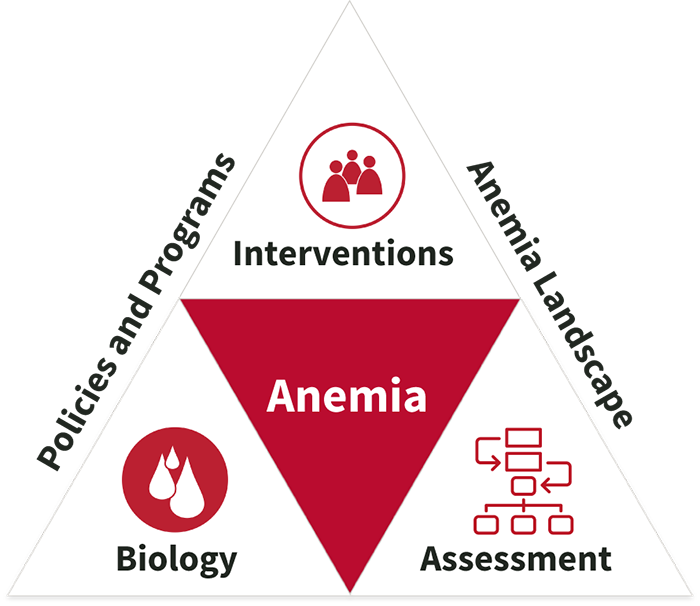Anemia is a public health concern disproportionately affecting young children, pregnant women, and women of reproductive age. The Global Burden of Disease Study estimates that iron deficiency anemia and thalassemia are the leading anemia causes worldwide.
While anemia is prevalent around the world, the underlying causes differ among different populations and regions. A “one size fits all” approach does not exist, and implementation of strategies to reduce anemia depend on the main causes of anemia, and the financial and technical capacity of each country.
We found 93 resource(s)
Risk Factors of Anaemia and Iron Deficiency in Somali Children and Women: Findings from the 2019 Somalia Micronutrient Survey
Journal Article published by Maternal & Child Nutrition in
This paper presents the results of Somalia's 2019 micronutrient survey that assessed the prevalence of anaemia and iron deficiency in children (6–59 months) and non-pregnant women of reproductive age (15–49 years), and its association with vitamin A deficiency, inflammation, malaria, and other potential risk factors for anaemia and iron…
The VitMin Lab Sandwich-ELISA Assays for Iron and Inflammation Markers Compared Well with Clinical Analyzer Reference-Type Assays in Subsamples of the Nepal National Micronutrient Status Survey
Journal Article published by Journal of Nutrition in
This study evaluates the analytical performance of the VitMin Lab enzyme-linked immunosorbent assay (ELISA) assays for serum ferritin, soluble transferrin receptor, C-reactive protein, and α-1-acid glycoprotein in comparison to a Roche clinical analyzer on serum samples from children 6–59 months and nonpregnant women who participated in the 2016…
Factors Associated with Anaemia Among Adolescent Boys and Girls 10–19 Years Old in Nepal
Journal Article published by Maternal & Child Nutrition in
This secondary analysis of data from the 2016 Nepal National Micronutrient Status Survey evaluates the factors associated with anemia, derived from altitude- and smoking-adjusted hemoglobin concentration values, among nationally representative samples of adolescents 10–19 years.
The Global Diet Quality Score Is Inversely Associated with Nutrient Inadequacy, Low Midupper Arm Circumference, and Anemia in Rural Adults in Ten Sub-Saharan African Countries
Journal Article published by Journal of Nutrition in
The study evaluated comparative performance of a novel food-based Global Diet Quality Score against other diet metrics in capturing nutrient adequacy and undernutrition in rural sub-Saharan African adults.
Complementary Feeding Indicators in Relation to Micronutrient Status of Ghanaian Children Aged 6–23 Months: Results from a National Survey
Journal Article published by GroundWork in
This study uses data from national cross-sectional survey conducted in Ghana in 2017 to examine how multiple World Health Organization-recommended complementary feeding indicators relate to anemia and the micronutrient status of children aged 6–23 months.
Perspective: Weekly Iron and Folic Acid Supplementation (WIFAS): A Critical Review and Rationale for Inclusion in the Essential Medicines List to Accelerate Anemia and Neural Tube Defects Reduction
Journal Article published by Adv Nutr in
This study reviews the results of a three-arm, parallel-group, randomized, double-blind, placebo-controled weekly iron and folic acid supplementation efficacy trial among Malaysian women aged 18–45 years, who were randomly assigned to three treatment groups—60 mg Fe as ferrous fumarate and either 0 mg, 0.4 mg, or 2.8 mg of folic acid, to be…
Anemia Prevalence in Women of Reproductive Age in Low- and Middle-Income Countries Between 2000 and 2018
Systematic Review published by Micronutrient Forum in
This report maps geospatial estimates of anemia prevalence between 2000–2018 in women of reproductive age (15–49 years) across 82 low- and middle-income countries and aggregates results to policy-relevant administrative and national levels
National, State and Union Territory, and District Fact Sheets 2019–21 National Family Health Survey NFHS5 (English)—India Fact Sheet
Technical Report published by DHS in
The Indian National Family Health Survey 2019–21 provides data on the status of anemia in children under five and women of reproductive age in India.



